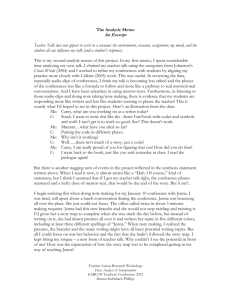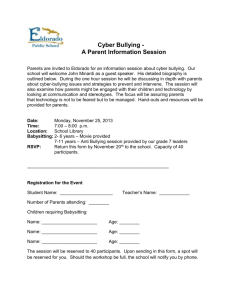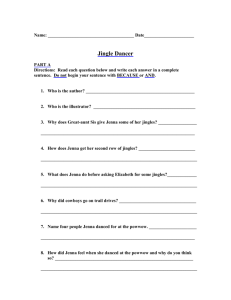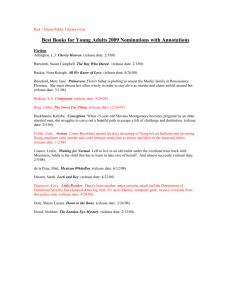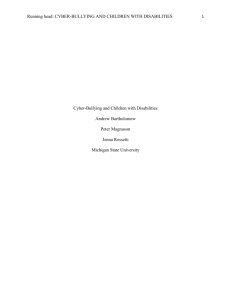PSY_493_Team_7_Report_2 - PSY-2013 - home
advertisement
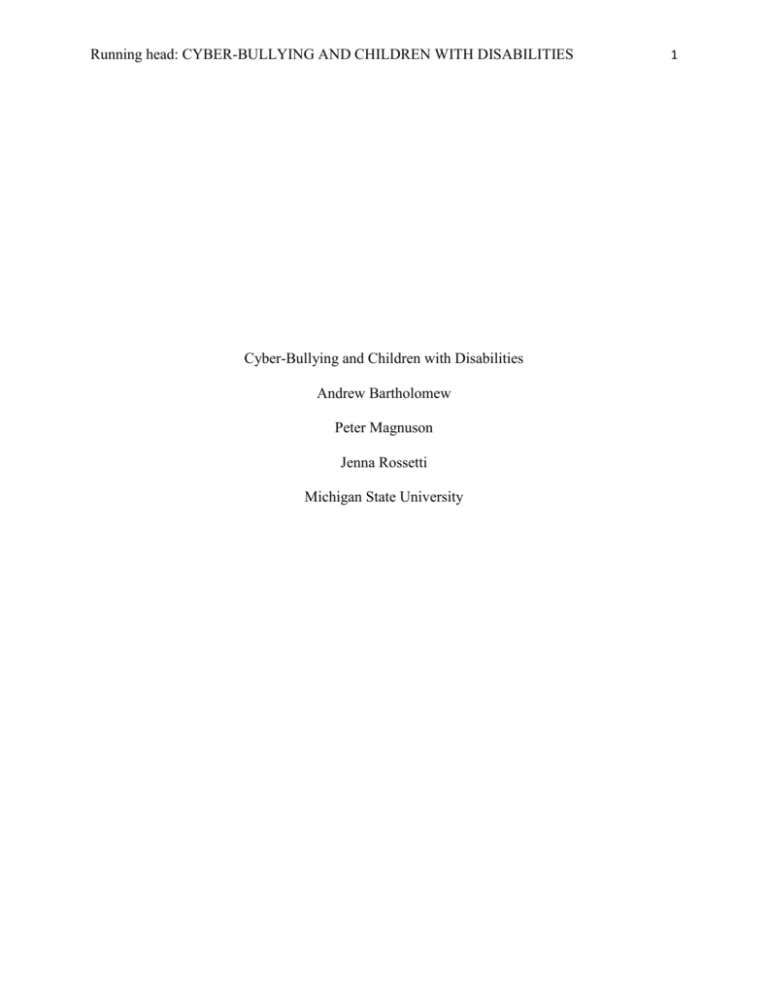
Running head: CYBER-BULLYING AND CHILDREN WITH DISABILITIES Cyber-Bullying and Children with Disabilities Andrew Bartholomew Peter Magnuson Jenna Rossetti Michigan State University 1 2 Cyber-Bullying and Children with Disabilities A. Chresta Brinkman, Colorado Hands & Voices B. Mission and Purpose, Roles / Responsibility According to the Colorado Hands & Voices website, the organization is: …dedicated to supporting families with children who are Deaf or Hard of Hearing without a bias around communication modes or methodology. We’re a parent-driven, non-profit organization providing families with the resources, networks, and information they need to improve communication access and educational outcomes for their children. Our outreach activities, parent/professional collaboration, and advocacy efforts are focused on enabling Deaf and Hard-of-Hearing children to reach their highest potential (Mission statement 2010). According to Chresta, her role is to “connect with referrals that come to Colorado Hands & Voices for families who have a child who has been identified as having a Unilateral (one sided) Hearing Loss. When I receive a referral I call the family and share our family story of our son, Noah, who was born with Goldenhar Syndrome and presents with Hemifacial Microsomia resulting in a moderate to severe hearing loss in his right ear. The family then shares their story with me and I am able to provide support and advocacy to them regarding their immediate and future needs.” C. Statement of Challenge / Requested Information Chresta has developed a “desire to learn more about bullying and the prevalence, prevention and impact on children who have special needs.” In pursuit of her desire to learn more about cyber-bullying of special needs children, Chresta would like the group to help her gather information about “the occurrence, description, impact, and prevention of cyber-bullying with children who have special needs.” D. Summary of Scientific Research Related to Challenge IMPACT: There was only a single article that dealt with both cyber-bullying and children with disabilities. In the Kowalski study, they looked at a very specific group of children; those with either ADHD or Asperger Syndrome. Their conclusions were not exactly startling: “Individuals not involved with bullying showed greater levels of physical and psychological health relative to those involved with bullying.” (Kowalski, 2011) One notable aspect of the study was that “Parents and children disagreed on a number of issues related to use of the Internet.” (Kowalski, 2011) 3 Cyberbullying in general seems to be associated with lower self-esteem for both the victim and the perpetrator (Pactchin 2010). Mishna and colleagues believe that “Cyber bullying often feels especially invasive because victims can experience it in their own home – a place where they should be able to feel safe.” (Mishna 2009) Of the focus groups they studied, all students from 5th to 8th grade, some “characterized online bullying as more serious than ‘traditional’ bullying because of the associated anonymity.” PREVALENCE: We were able to find other studies that discussed bullying, in general (not necessarily cyber-bullying), on special needs children. In the Twyman study, the authors examined quite a wide range of special needs children. They examined children with learning disabilities, attention deficit or hyperactivity disorder, autism spectrum disorders, behavioral or mental health disorders, and cystic fibrosis. (Twyman 2010) The authors compared these groups to a control group and found “significant victimization.” Their conclusion was that “children with special health care needs may be at higher risk for bullying, victimization, and ostracism.” (Twyman 2010) Another Mishna study of general middle and high school students “found that over 30% of the students in this study identified as involved in cyber bullying, as victims or perpetrators, and one in four of the students (25.7%) reported having been involved in cyber bullying as both bully and victim during the previous three months.” (Mishna 2012) One study did help shed some light on the likelihood of bullying disabled victims. The pacer site states that “children with disabilities were two to three times more likely to be bullied than their nondisabled peers.” (Bullying, 2012) PREVENTION: A number of preventative strategies are being advocated. For special needs children, van der Zande recommends families create a safety plan that involves these points: Integrate the teaching of personal safety skills along with other skills in your dayto-day life. Make a Safety Plan for how to get help everywhere you go and review that plan until you are sure that everyone understands Teach children to speak up for themselves if they can and teach everyone who comes in contact with vulnerable children how to be their advocates. Be realistic if your child is likely to wander off and does not have the ability to follow a safety plan or communicate with others. Protect your family’s emotional safety from the thoughtless unkind things that others sometimes say and do. Take responsibility for the ways in which your child might cross the boundaries of others. Make time for the children in your family who do not have special needs to learn age-appropriate personal safety skills. 4 Take care of yourself.(van der Zande 2012) Kraft and colleagues suggest that “removing the offender’s access to social networking sites and the parents taking away the offender’s computer and cell phone would be the most effective preventative strategies.” (Kraft 2009) E. Possible Solutions for Organization’s Challenge Based on Scientific Research Findings Prevention of bullying special needs children would seem likely to run into many of the same problems as bullying in the general population. All of the typical anti-bullying tactics should be used: school programs that try to create empathetic students who’ll step in when they see bullying, and programs to make the educators aware of the serious consequences of bullying. In addition to these programs, van der Zande’s safety plan would seem to offer practical advice for families with special needs children. (van der Zande 2012) One unique aspect to cyber-bullying is the ability to shut down or block access to the technology needed to carry out attacks. Many social networking sites / services have anti-abuse policies. Additionally, parents can be recruited to help deny access to these tools. (Kraft 2009) F. Revision of Solutions Based on Feedback from Professional We haven’t yet presented our findings to our professional. We will update this section when we have more information. G. References 5 References Bulent, D., and Didem, A. (2010). Parental attitudes as a predictor of cyber bullying among primary school children. International Journal of Human and Social Sciences, 5(10), 649653. (2012). Bullying and harassment of students with disabilities. Retrieved from http://www.pacer.org/bullying/resources/students-with-disabilities/ Kowalski, R. M. and Fedina, C. (2011). Cyber bullying in ADHD and Asperger Syndrome populations. Research in Autism Spectrum Disorders, 5(3), 1201-1208. Kraft, E. M., and Wang, J. (2009). Efffectiveness of cyber bullying prevention strategies: a study on students’ perspectives. International Journal of Cyber Criminology, 3(2), 513-535. Limber, S. P. (2007). Bullying among children and youth with disabilities and special needs. Retrieved from http://www.ldonline.org/article/20001/ Miller-Perrin, C. L., & Perrin, R. D. (2013). Child maltreatment: An introduction. 3rd Edition. Sage Publications, Inc: Thousand Oaks, CA.. Mishna, F., Khoury-Kassabri, M., Gadalla, T., and Daciuk, J. (2012). Risk factors for involvement in cyber bullying: Victims, bullies and bully-victims. Children and Youth Services Review, 34(1), 63-70. Mishna, F., Saini, M., and Solomon, S. (2009). Ongoing and online: children and youth’s perceptions of cyber bullying. Children and Youth Services Review, 31(12), 1222-1228. Mission statement. (2010). Retreived July 17, 2013, from http://cohandsandvoices.org/about/mission.html. Pactchin, J. W., and Hinduja, S. (2010). Cyberbullying and self-esteem. Journal of School Health, 80(12), 614-621. PeaceBuilders applauds governor brown for signing cyber bullying prevention law. (2011, Jul 13). Business Wire. Retrieved from http://ezproxy.msu.edu/login?url=http://search.proquest.com/docview/876181708?accoun tid=12598 Twyman, K. A., Saylor, C. F., Saia, D. E., Macias, M. M., Taylor, L. A., and Spratt, E. (2010). Bullying and ostracism experiences in children with special health care needs. Journal of Developmental and Behavioral Pediatrics, 31(1), 1-8. van der Zande, I. (2012). Bullying – common questions and answers from kidpower. Retrieved from http://www.kidpower.org/library/article/bullying-questions-answers/ 6 van der Zande, I. (2012). Kidpower safety plans for children with disabilities. Retrieved from http://www.kidpower.org/library/article/safety-plans-disabilities/ H. Communication Log Communication Log Team 7: Jenna Rossetti, Andrew Bartholomew, and Peter Magnuson Bright Spot: Mrs. Chresta Brinkman DATE TIME TOPIC SUMMARY Jenna (Team Communicator) introduced herself on the discussion board to Andrew (Team Researcher) and Pete (Team Writer). She says that she will be emailing the team bright spot within the next week. She also tells the other team members to check out Mrs. Brinkman’s wiki page to learn more about her. She closes by asking Andrew and Peter if they had any questions for the bright spot, to let her know and she will ask Mrs. Brinkman. 7/9 Dr. Johnson hadn’t put the link up for Mrs. Brinkman’s wiki page so Jenna commented again to disregard her statement about checking out Mrs. Brinkman’s wiki page. Dr. Johnson answered Jenna’s first discussion post by saying that he would put up a second link for Mrs. Brinkman as soon as possible. 7/10 7/11 Andrew replied to Jenna’s discussion by introducing himself. 7/11 1:47pm Jenna initiates contact with Mrs. Brinkman via email: introducing herself and her team; thanking her for her participation; questioning the best way to contact her; and requesting the information necessary to complete Team Report #1. 7/11 Jenna posts a second topic on the discussion board. She tells Andrew and Pete that she has emailed Mrs. Brinkman and also ‘cc’ed them in that email so they may read what she wrote. She says that she will let them know when Mrs. Brinkman responded. 7/12 Dr. Johnson replied to both discussion posts that Jenna had created. In the first post, he said that he had finally put up Mrs. Brinkman’s wiki link and in the second one, he says that he believes that our team will learn a lot from 7 our team bright spot. 7/12 2:03pm Mrs. Brinkman promptly replied to Jenna’s email: She had attached a document that had all the necessary information to complete our first team report. 7/15 Jenna posts again on the discussion board, titling it “First Email Back”. She lets the team know that she has received a reply from Mrs. Brinkman with all the necessary information to complete Team Report #1. She says that she will email Andrew and Pete the document that Mrs. Brinkman had send her with all the information they needed. 7/15 Jenna sends Andrew and Pete a copy of Mrs. Brinkman’s document via email. She also reminds the team of all the content that must be included in 12:30pm that report. 7/16 Dr. Johnson replies to Jenna’s “first email back” post. He said that the team was on the right track and added some reminders about the format of Team Report #1. 7/17 Andrew replies to Jenna and Pete via email. He said that it looked like Mrs. Brinkman had answered everything we needed to know for our first report. He wanted to know what else he could do to assist with Team Report #1. 7/17 1:46pm 2:30pm Peter responds to Andrew’s question via email: He said that there wasn’t much that Andrew could do on this initial report. He said that he would send out a draft of the first report to Jenna and Andrew once he got out of work. Andrew emailed a draft of Team Report #1 to Jenna and Andrew to look over. He asked if Jenna wanted to add the communication log to his word document. 7/17 5:31pm Jenna said that she did not need Pete to attach the communication log to his document because there was a separate drop box for it. Mrs. Brinkman replied to Jenna’s “first email back” post. She glad that Jenna received the document and that she’s excited to hear more from us. 7/17 Dr. Johnson also replied to the post. He reminded team members that all group members need to assist the team researcher (Andrew) with the 8 research process. Jenna responded to Dr. Johnson. She asked if it was okay for her to complete the communication log in Microsoft Exel. Pete sent an email to Andrew and Jenna to let them know that he had posted Team Report #1 to our wiki page. 7/18 12:08am Jenna replied promptly to let Pete and Andrew know that she had posted the Communication log as well. Dr. Johnson posted on the “first email back” discussion board. He said for the team members to look at the feedback given to us on Team Report #1 and Communication Log. 7/19 Dr. Johnson posted on the discussion board to remind team members to use APA format and to get our research material from professional references only. 7/25 Mrs. Brinkman also posted on the discussion board to let team members know that she would be out of town that weekend and that if they needed to ask her any questions to try to email her before then. She said she would be free the following week until the next weekend to answer questions. 7/28 11:43am Andrew sent Pete and Jenna a document via email that had all of the information he had found to use in our final paper. This document had links, important quotes, and other helpful information. He asks if there is anything else that he could do to help with the writing process and that if Pete and Jenna had any questions to just email him. Andrew posted to the discussion board letting team members know that he had sent them both an email with all his research information. 7/29 Jenna posted on the discussion board. She said that the research Andrew did was great. She wondered if there were any questions for Mrs. Brinkman. 7/29 7/30 Andrew sent out an email asking Pete and Jenna if any progress had been made on our Team Report #2. He reminded team members that he had 10:11pm sent out an email and posted to the discussion board. Jenna apologized to Andrew for not returning his email right away. She had 9 8:53am 7/30 7/30 7/30 been busing with her other two classes, but she said that his research was really good and that they could use it in their final paper. She told Pete and Andrew that she was rewriting the Communication Log tonight and that she would send them a draft when she completed it. 10:57am Pete told Andrew and Jenna via email that he would look at Andrew’s research when he got out of work later that night. 4:02pm Dr. Johnson posted to the discussion board some more literary resources that the group should use in their final paper. 8:10pm Jenna emailed Andrew and Pete a copy of the revised Communication Log. She asked how to correctly adjust the format on the table.
